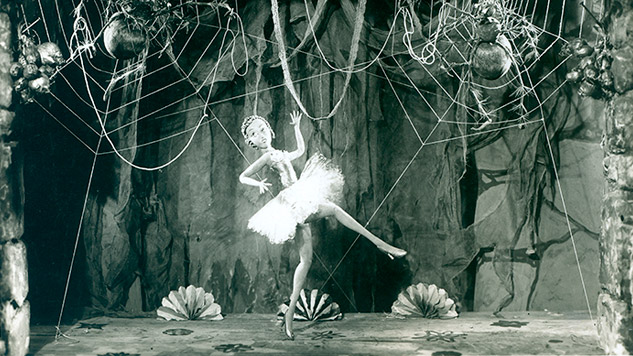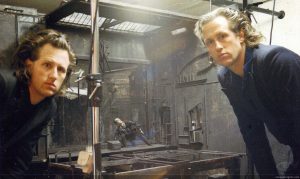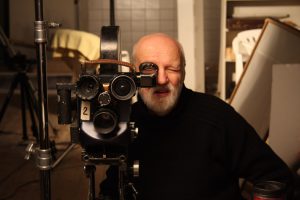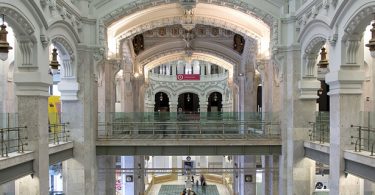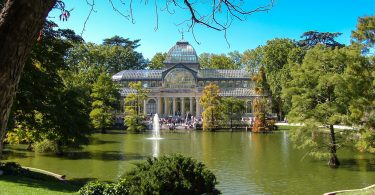Until de 11th of January 2015 you can still check out the temporally exhibition called Metamorphosis; Fantastic visions of Starewitch, Švankmajer and the Quay brothers in La Casa Encendida in Madrid.
La Casa Encendida is a private cultural foundation that supports avant-garde art throughout temporally exhibitions. The foundation also shows art movies, gives courses and organises cultural lectures. Its located in the city centre of Madrid, on the Ronda de Toledo, nearby the Reina Sofia museum. At the moment they have a very interesting temporally exhibition which is also very suitable to visit with children as it is a walk through an imaginary world created for a wide variety of animation movies.
The exhibition shows, besides some very creative animation movies, also a wide variety of props and objects used by filmmakers Ladislas Starewitch (1882-1965), the Quay brothers and Czech artist Jan Švankmajer. The exhibition is an original, imaginary tour through the liberal minds of these artists and tries to explain how these artists created their unique, animation movies through marionettes, drawings, sculptures, paintings and photographs. Every Saturday and Sunday you can also take a guided tour (in Spanish) where experts explain more about the artists and their work. The guided tours are held at 12, 14, 17 and 20:00 hours.
The oldest artist on display is Ladislas Starewitch, a Russian/French stop-motion animator who is known as the creator of the first puppet-animated film called The Beautiful Lukanida (1912). Starewitch was intrigued by nature and insects since he was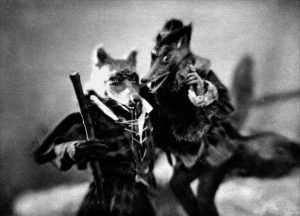 young and he used them and other animals as protagonists for his animation movies. Since 1911 he made over forty animation and normal movies and he directed the first Russian film, La Cigale et la Fourmi, to be shown abroad. The longer Starewitch worked in the cinema though, the less he liked directing actors, for they never did what he wanted them to do and this led him to experiment with marionettes and other self created props.
young and he used them and other animals as protagonists for his animation movies. Since 1911 he made over forty animation and normal movies and he directed the first Russian film, La Cigale et la Fourmi, to be shown abroad. The longer Starewitch worked in the cinema though, the less he liked directing actors, for they never did what he wanted them to do and this led him to experiment with marionettes and other self created props.
Starewitch work is on the whole very curious and bizarre in style, and although his work never became very popular he certainly was a big inspiration for well known movie directors like Tim Burton and Wes Anderson. Often mentioned as being among his best work is The Tale of the Fox (also known in French: Le Roman de Renard) which was also his first animated feature movie. It was entirely made by him and his daughter, Irene, and it premiered in Berlin in 1937.
Other animation movies that are shown at the exhibition are made by the Quay Brothers. These American identical twin brothers, born in 1947 in the United States, live and work now in England where they develop and create the most creative animation movies. Most of their animation films feature puppets made of doll parts and other organic and inorganic materials, often partially disassembled, in a dark, moody atmosphere. Perhaps their best known work is Street of Crocodiles, based on the short novel by the Polish author and artist Bruno Schulz. This short film was selected by director and Monty Python animator Terry Gilliam as one of the ten best animated films of all time, and critic Jonathan Romney included it on his list of the ten best films in any medium.
The last artist on display is the Cezch artist Jan Švankmajer (1934). Today Švankmajer is one of the most celebrated animators in the world but his surreal, grotesque and censor-baiting films have been getting him into trouble for years. At this exhibition you can see some of his most famous animation movies like Alice, (1988), based on Lewis Carroll’s book, Alice in Wonderland, where common objects suddenly come to live creating strange and fantastical images that are fascinating to watch.
Švankmajer´s actors include everything; from real people, to machines, socks, clay figures, antique dolls, pencil sharpeners, and skeletons or stuffed corpses of animals, among other things. His sets are usually decaying Czech buildings or landscapes, decorated with waste of the industrial age: rotting furniture, rusty nails, sawdust, oily screws, and the like, which creates a strange a out of space ambience in most of his animation movies.
Švankmajer started collecting objects as a child and his first collection was of one of razor blades. When he was seven he was given a puppet theatre by h is father and his art and film-making are a continuation of those first successions. Besides Švankmajer´s motion work you can also see at the exhibition some of his other interesting art work, (which is perhaps not always so suitable for children as some contain sexual images) from drawings to collages and his ‘tactile sculptures’, many of which were produced in the mid-1970s, when he was temporarily banne
is father and his art and film-making are a continuation of those first successions. Besides Švankmajer´s motion work you can also see at the exhibition some of his other interesting art work, (which is perhaps not always so suitable for children as some contain sexual images) from drawings to collages and his ‘tactile sculptures’, many of which were produced in the mid-1970s, when he was temporarily banne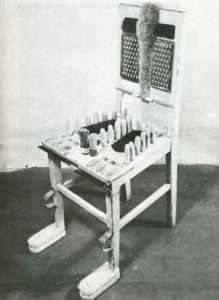 d from film-making by the Czech authorities. The sculptures were created mostly together with his late wife Eva Švankmajerová. Švankmajer experimented intensively with the tactile experience in a surrealistic way and this can be seen throughout the objects, drawings and collages shown. There is for example a tactile chair and also a tactile massage installation with 4 arms attached. Al these objects are in a different room and can be visited separately as well if necessary. Don’t forget to also check out in this room the rare Salvador Dalí that is here also on display here called Dali, Transformation of a painting anonymous 16th century (attributed to Matthias Gerung) 1974.
d from film-making by the Czech authorities. The sculptures were created mostly together with his late wife Eva Švankmajerová. Švankmajer experimented intensively with the tactile experience in a surrealistic way and this can be seen throughout the objects, drawings and collages shown. There is for example a tactile chair and also a tactile massage installation with 4 arms attached. Al these objects are in a different room and can be visited separately as well if necessary. Don’t forget to also check out in this room the rare Salvador Dalí that is here also on display here called Dali, Transformation of a painting anonymous 16th century (attributed to Matthias Gerung) 1974.
Besides this exhibition, the Casa Encendida also organises a lot of activities especially focused on children and you can check out their agenda for December 2014 on this link.



